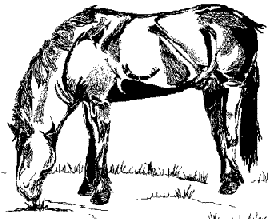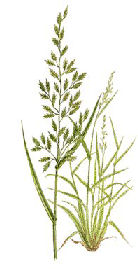Fescue Toxicosis in Horses

Equine fescue toxicosis is caused when pregnant mares eat tall fescue that is infected with an endophyte fungus, Acremonium coenephialum . Both the mare and the foal can be affected when the mare eats endophyte-infected fescue.
A pasture seeded with fescue may look appetizing to a horse (and its owner!), but don't judge a book by its cover!
All is not lost if your broodmare eats endophyte-infested fescue. Treatment is available, although prevention is the best protection.
Tall Fescue - the plant

*** Image from TIME LIFE Plant Encyclopedia.
Tall fescue is a hardy, popular, cool season perennial grass that can grow on a variety of soils in a variety of climates. It is grown on an estimated 35 million US acres.
Advantages of tall fescue
- Cool season perrenial grass
- High yield
- Drought resistant
- Resistant to overgrazing
- High quality nutrient source
Disadvantages of tall fescue
- alkaloid production by plant itself
- Endophyte infection --> produces even more damaging alkaloids such as the indole alkaloid ergovaline
Managing Endophyte-Infected Tall Fescue
Converting endophyte-infected fescue to endophyte-free pasture is a challenging task. Changing to endophyte-free fescue may not be the best idea because the endophyte increases the forage's hardiness and promotes growth on marginal soils.
Another option is to diversify a pasture with other forages. This helps reduce fescue toxicity by diluting the concentration of infected fescue.
Nitrogen fertilization appears to increase ergovaline levels in endophyte-infected fescue. Ergovaline levels also increase as plant matures and seed heads form. Keeping livestock off fescue pastures after seed heads appear is advisable, but not always practical. If you cut tall fescue for hay, do it prior to seed head formation, otherwise the hay and remaining stover will be high in ergovaline.
Eradication
There are three main methods of eliminating endophyte infected fescue. They all involve eliminating the existing fescue, and replanting with endophyte-free fescue seeds .
- Fastest Method:
- Prevent seedhead formation in spring by mowing.
- In late summer, spray pasture with herbicide, in 2 applications a week apart.
- Plant endophyte-free seed
- There is about 50% chance of endophyte-infected fescue reappearing.
- Intermediate Method:
- Spray fescue with herbicide before seeds form.
- Plow pasture.
- Plant summer annual.
- In fall, spray herbicide on recovering fescue.
- Plant endophyte-free seeds.
- Better chance of killing infected fescue.
- Long Method:
- Late summer or ealy fall, spray with herbicide.
- Plant winter annual: grass and legume or grass with nitrogen fertilizer.
- In spring, spray with fertilizer.
- Late summer or fall, sray with herbicide if necessary, and plant endophyte free seeds.
- Best chance of killing infected fescue.
Acremonimum coenophialum - the endophyte
The endophyte, Acremonimum coenophialum, grows symbiotically with tall fescue. It is similar to the ergot fungus although A. coenophialum is evolutionarily derived from Epicloe typhina. This fungus is the reason for some of the advantages of fescue, such as insect resistance. However, it is also the cause of the toxicity. The endophyte produces the toxic alkaloid substances (there is also some alkaloid produciton by the fescue itself). The major alkaloid produced is the indole alkaloid, ergovaline.
The endophyte grows between the plant cells. It is most proliferative in the spring, and closely associates with the growing flower and seed head. It is through contamination of the seed that infection of fescue is spread. Plant to plant or field to field transmittion of the endophyte is very limited.
Fescue Alkaloids and Toxic Effects
Tall fescue produces the two diazaphenanthrene alkaloids, perlolidone and perloline. Under lab conditions, administrating perloline to sheep has caused mild photosensitivity, increased pulse and respiration rates, loss of muscle control, convulsions, and comas. However, perloline and perlolidone do not appear to be responsible for the fescue toxicities observed under field conditions.
Rather, alkaloids produced by the endophyte appear to be the culprits. Acremonimum coenophialum produces both loline and ergopeptine classes of alkaloids. The lolines are saturated pyrrolizidine alkaloids with mild vasoconstrctive properties. They may possibly contribute to the hyperthermia (elevated body temperatures) and fescue foot (gangrene of the animal's extremeties, often the rear hooves or tail tip) observed in cattle and sheep poisoned by fescue. However, the ergopeptine class of alkaloids produced by Acremonimum coenophialum were shown in the mid-1970s to be the primary causative agents of fescue toxicity.
Ergopeptines are indole alkaloids that help chemically defend the fescue plants from insect pests and also have a positve influence on plant hormones and/or growth regulators. Unfortunately, they interfere with prolactin secretion, body temperature regulation, and feed intake of livestock grazing the infected fescue. Additionally, these alkaloids can constrict blood vessels, and reduce blood flow to the extremities.
The primary ergopeptine in fescue is ergovaline.
Others include
- ergosine
- ergonine, and
- lysergic acid amine (structurally similar to LSD)
Fescue Toxicosis: Effects on Broodmares
Unlike other livestock, the signs of fescue toxicity in horses are almost exclusively related to poor reproduction. Mares that consume large amounts of endophyte-infested tall fescue can suffer from a number of reproductive problems. These can include
- prolonged gestation
- abortion
- premature separation of the chorion
- dystocia
- thickened placenta
- retained placenta
- aglactia (suppression of lactation, i.e. no milk)
Additionally, mares who graze endophyte-infested fescue pastures in early pregnancy may have delayed pregnancy rates or early embryonic death.
Prolonged Gestation
The normal gestation length in horses is approximately 11 months. However, mares that graze on endophyte-infected fescuecan have pregnancies that last up to 13 months or more. This is a problem because the fetus continues to grow during the extra timewhich can result in dytocia (difficult birth). The foals born after prolonged gestation may appear to be immature despite their extra fetal development.
The characteristics of a foal born after prolonged gestation include a large frame size and poorly developed muscles. Also, some foals may have overgrown hooves, while others may have premature and irregular eruption of baby teeth. These foals can also exhibit hyperthyroidism, resulting in poor suckling reflex, incoordination, and low body temperature.
Fescue Toxicosis: Effects on Foals
The newborn foal can suffer greatly from the effects of fescue toxicosis. The range of fetal deaths in the last third of pregnacy for herds affected by fescue toxicity varies from 0 to100%. Generalized symptoms associated with foals born to mares grazing on endophyte-infected fecsue include
- prolonged gestation
- dystocia
- abnormal foal maturation
- weakness
- starvation (due to dam's agalactia)
Poor Immunity in Foals
Many foals born to mares pastured on endophyte-infected fescue have reduced immunity, which makes them highly susceptible to infections. Normally, foals receive antibodies from the mare in the form of colostrum, consumed almost immediately after birth. However, mares affected with fescue toxicosis are often agalactic, and so their production of milk is limited or nonexistant. Thus, the newborn foal is not able to consume enough colostrum to have an adequate transfer of antibodies from the mother to the foal. The foal is at risk to contract a number of illnesses and infections.
If a mare does not supply an adequate amount of milk or colostrum to the newborn foal, the foal should be given colostrum from a donor mare, or colostrum that is stored in a colostrum bank. If neither of these options is available, the foal should be given colostrum from another species of animal, followed by intravenous antibodies and a diet of supplemental milk. Cow or goat milk is often used, although additional sugar (in the form of dextrose) is added to more closely resemble the mare's milk.
Treatment of Fescue Toxicity
The best form of treating fescue toxicosis in horses is prevention. However, this is not always possible. Nonpregnant horses can safely graze on endophye-infected fescue pastures, as can broodmares during the second trimester of pregnancy. If a pregnant horse must graze on endophyte-infected fescue, there are pharmaceuticals available to help reduce the adverse effects.
Some of the available drugs include:
- domperidone (which prevents ergovaline from inhibiting prolactin release and, hence, prevents agalactia).
- perhenazine
- reserpine
More Information on Fescue Toxicosis in Horses
Fescue toxicosis is not unique to horses; it can affect any species of livestock that graze on endophyte-infected fescue. Some additional sources of information on fescue toxicosis include
This series of web pages was created by an undergraduate student at Cornell University for the AS625 class.
WARNING: These web pages are only meant to be informative. Neither Cornell University nor the author of this site endorse or recommend the use of these plants.